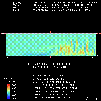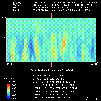Large-Eddy Simulations #37 and #39: Lake-ICE TIBL
LES 39 is simply a continuation of LES 37 with predictive TKE turned
on. The first 32-minutes, LES 37, was run without predictive TKE.
Turning on the predictive TKE disrupts the
apparently "frozen rolls" which form during the first 32 minutes.
PROBLEMS: (1) In this simulation, the air flowing into the domain on
the western wall is not turbulent. Yet, we have no observations of
laminar air advecting offshore. Instead, we've always observed some
type of pre-existing mixed-layer which the lake driven boundary layer
grows into. We expect this strongly effects the growth rate of the
TIBL and convective structures. (2) "Frozen rolls" develop. Lidar
observations usually show cells in the lower ML, and constantly
changing patterns elsewhere. (3) The model does not have stochastic
backscatter built in. This may effect the solution (see Mason &
Thomson, 1992, JFM, 51-78.) (4) Grid-anisotropy approaches 15:1
near the bottom of the model. (5) The wind has been adjusted
so that it blows perpendicular to a straight shoreline.
Future simulations will address these issues.
ACHIEVEMENTS: The model produces steam-fog, accelerating winds, and a
mixed layer that deepens with offshore distance. Non-periodic
inflow and outflow boundary conditions are implemented.
We ran 6.4 million grid
points at 0.25 s time step for about 6 weeks to produce this 1-hour
simulation. The mesh size matches the lidar resolution (15 m)
and the domain begins to cover scales which could contain several
rolls, cells, etc.
LES RUN #37 and #39:
Click here to see the
NMSTASK file for LES 37.
Click
here to see the NMSTASK file for LES
39.
This domain is 6 km (east-west) by 3 km (north-south)
wide.












UW Lidar // Feb 18, 1999 // root@lidar.ssec.wisc.edu
Return to the
 Index
Index
 Index
Index











 Index
Index